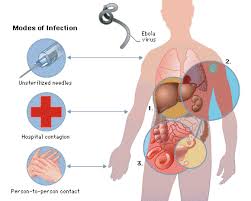 Ebola virus: A notoriously deadly virus that causes fearsome symptoms, the most prominent being high fever and massive internal bleeding. Ebola virus kills as many as 90% of the people it infects. It is one of the viruses that is capable of causing hemorrhagic (bloody) fever.
Ebola virus: A notoriously deadly virus that causes fearsome symptoms, the most prominent being high fever and massive internal bleeding. Ebola virus kills as many as 90% of the people it infects. It is one of the viruses that is capable of causing hemorrhagic (bloody) fever.Epidemics of Ebola virus have occurred mainly in African countries including Zaire (now the Democratic Republic of Congo), Gabon, Uganda, the Ivory Coast, and Sudan. Ebola virus is a hazard to laboratory workers and, for that matter, anyone who is exposed to it.
Infection with Ebola virus in humans is incidental -- humans do not "carry" the virus. The way in which the virus first appears in a human at the start of an outbreak has not been determined. However, it has been hypothesized that the first patient (the index case) becomes infected through contact with an infected animal.
Ebola virus is transmitted by contact with blood, feces or body fluids from an infected person or by direct contact with the virus, as in a laboratory. People can be exposed to Ebola virus from direct contact with the blood or secretions of an infected person. This is why the virus has often been spread through the families and friends of infected persons: in the course of feeding, holding, or otherwise caring for them, family members and friends would come into close contact with such secretions. People can also be exposed to Ebola virus through contact with objects, such as needles, that have been contaminated with infected secretions.
The Ebola virus was first isolated in1976 from the dual outbreaks that occurred in Zaire and Sudan. It is a zoonotic disease as it affects lowland apes as well as humans.
16000 deaths is not even remotely correct. There have been about 1850 cases and 1200 deaths (65% mortality)
ReplyDeleteYou should look that up next time instead of making up numbers!